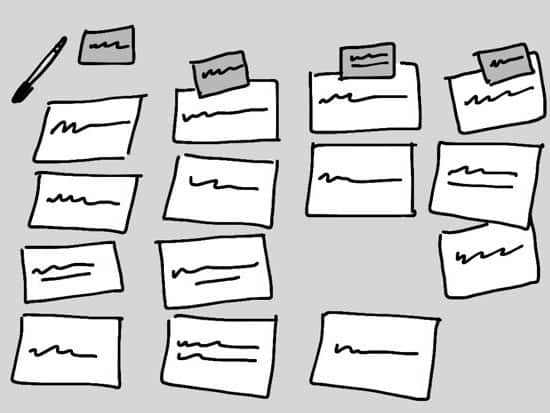Card Sorting is the third in our series of Design Games.
Is this your first time visiting our design games series? A design game is basically a fun activity played by a small team and used to provide input to a design problem. They may involve users of a product, a project team, stakeholders, or even management.
For a more detailed description of what a design game is, check out our first design game post.
Description of Card Sorting
Card sorting is a common user research technique. You can make a card sort more fun (more game-like) by introducing a tight timeline, prizes for the first to finish or prizes for the most innovative labelling.
Prepare
Card sorting can take a fair amount of preparation, so ensure you leave plenty of time.
You will need:
- A set of index cards. On each index card, list one item of content or one object for the card sort.
- Sticky notes
- Markers
The most time consuming and trickiest aspect of preparing a card sort is to select content to include on the cards. The content may be:
- potential functions (if you are using the game for application menu design)
- pages or sections of content (for websites and intranets)
- products or similar objects
Run
Card sorting is best run in small groups as you can learn a lot from listening to how the group discusses the cards. You can run it as an individual activity if it is more important to collect a lot of data than to understand the rationale.
To run the card sort:
- Introduce the game by explaining what sort of information is on the cards
- Explain what the context or purpose is (e.g. it is for a website, an application or just to understand about grouping)
- Ask participants to sort the cards in a way that makes sense to them (make sure they know there is no ‘right’ answer)
- When it looks like participants have done some initial grouping, provide them with sticky notes and ask them to label each group with a short description.
When participants have finished, ask them to have a look at each other’s groups, and ask them to explain their rationale or aspects they found easy and difficult.
Record the results! (come back to this)
Analyse
The amount of analysis you do is dependent on what you need to get out of the game. Different levels of analysis include:
- Understanding participants’ rationale for their sort.
- ‘Eyeballing’ the data to spot consistent and different groupings and labelling
- Using my card sort analysis spreadsheet to explore patterns and get some basic statistics showing what cards were placed in what catgegories.
- Statistical analysis using one or more forms of cluster analysis or multi-dimensional scaling
Card Sorting Game at a glance
- Duration: Up to 1hr
- Group structure: Small teams
- Outcome: Language & categories
- Preparation needed?: Yes
- Who to involve: Users

